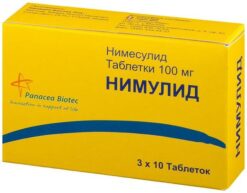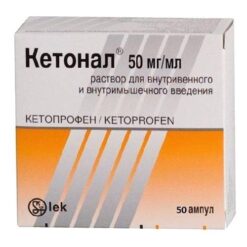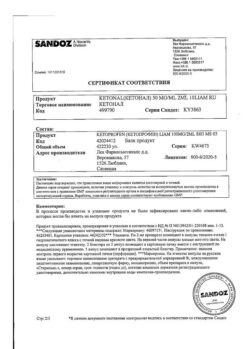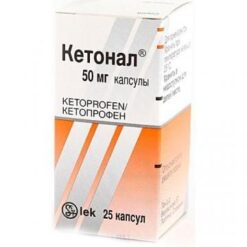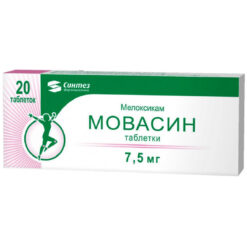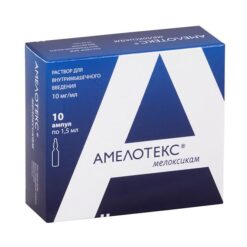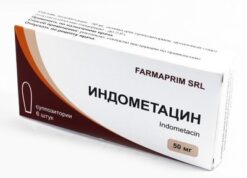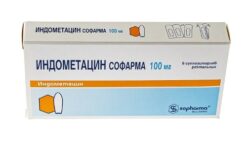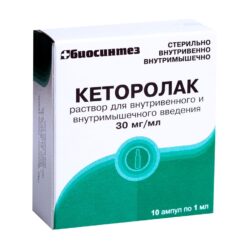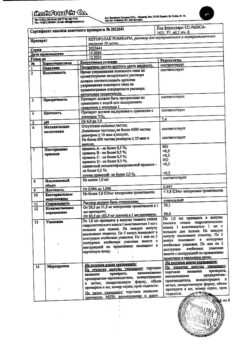No products in the cart.
Rakstan-sanivel, 100 mg 30 pcs
€16.88 €14.06
Description
Non-steroidal anti-inflammatory drug (NSAID)
ATX Code
M01AE09
Pharmacodynamics: Non-steroidal anti-inflammatory drug has anti-inflammatory analgesic and antipyretic effects. The main mechanism of action is related to the inhibition of prostaglandin synthesis by blocking cyclooxygenases (COX-1 and COX-2). Other mechanisms of decrease of tissue sensitivity to inflammatory mediators also take part in realization of therapeutic action of the preparation.
Pharmacokinetics: After oral usage the preparation is well and fully absorbed from digestive tract and reaches maximum concentration in plasma (on average 15 mkg/ml) 1-2 hours later. Food intake does not affect the bioavailability of the drug. The elimination half-life is 6 hours on average. Binding to plasma proteins is more than 99%. Flurbiprofen is almost completely metabolized and excreted mainly by the kidneys (glucuronides and sulfated conjugates): 20% unchanged.
Indications
Indications
Active ingredient
Active ingredient
Composition
Composition
Each tablet contains:
active ingredient: flurbiprofen 100 mg.
excipients: lactose monohydrate, microcrystalline cellulose, croscarmellose sodium, hyprolose, magnesium stearate, colloidal silicon dioxide. coating: opadray blue dye (lactose monohydrate, hyprolose, titanium dioxide, macrogol 4000, indigo carmine).
How to take, the dosage
How to take, the dosage
The daily dose of 150-200 mg: should be divided into 2-3 doses per day. In patients with acute symptoms or during exacerbation of the disease, the daily dose briefly (2-3 days) can be increased to 300 mg.
Dysmenorrhea:
in the beginning 100 mg followed by 50 or 100 mg every 4 or 6 hours. The maximum daily dose of the drug should not exceed 300 mg.
Interaction
Interaction
Co-use of the drug with anticoagulants (e.g., warfarin) leads to an increased risk of serious bleeding.
Concomitant use with acetylsalicylic acid leads to a significant decrease in the drug concentration in the blood serum.
Increases the likelihood of side effects of other nonsteroidal anti-inflammatory drugs and glucocorticosteroids
(bleeding in the gastrointestinal tract) methotrexate toxicity and cyclosporine nephrotoxicity.
Flurbiprofen reduces hypotensive activity of beta-blockers.
Reduces the effect of diuretics (furosemide thiazide diuretics) against potassium-saving diuretics increases the risk of hyperkalemia.
Special Instructions
Special Instructions
Synopsis
Synopsis
Contraindications
Contraindications
Hypersensitivity to flurbiprofen and other NSAIDs;
gastrointestinal erosive ulcers (acute phase);
bleeding from the gastrointestinal tract and cerebrovascular bleeding;
Bronchial asthma combined with nasal polyposis;
decompensated chronic heart failure;
treatment of post-operative pain after coronary artery bypass grafting;
haemostasis disorders (including haemophilia in the acute stage).
Hemophilia disorders (including hemophilia – prolongation of bleeding time, susceptibility to bleeding);
expressed hepatic or renal insufficiency;
children under 15 years of age;
pregnancy and lactation.
With caution:
Anemia hematopoiesis disorders bronchial asthma chronic heart failure arterial hypertension coronary heart disease edema syndrome hepatic and/or renal failure alcoholism inflammatory bowel disease diverticulitis erosive ulcerative diseases of the gastrointestinal tract beyond exacerbation sugar diabetes state after extensive surgical procedures induced porphyria elderly age.
Side effects
Side effects
The digestive system: more frequently 1% – nausea vomiting diarrhea constipation abdominal pain flatulence increase in the level of “liver” enzymes gastrointestinal bleeding
less frequently 1% – peptic ulcer with possible complications (bleeding perforation) gastritis jaundice melena appearance of blood in vomit masses esophageal lesions aphthous stomatitis glossitis hepatitis.
Nervous system: more often 1% – headache dizziness anxiety sleep disturbance increased reflexes tremor amnesia asthenia depression somnolence;
less often 1% – ataxia ischemic brain damage weakness paresthesias seizures.
Senses: more often 1% – visual impairment (blurred vision scotoma diplopia) tinnitus, decreased hearing; less often 1% – conjunctivitis impaired sense of smell and taste;
relationship with the drug is not identified – increased intraocular pressure retinal hemorrhage retrobulbar neuritis.
Skin: more often 1% – skin itching skin rash, less often 1% – alopecia urticaria eczema toxic dermatitis erythema multiforme exudative including Stevens-Johnson syndrome toxic epidermal necrolysis (Lyell’s syndrome) hypersensitivity.
Urinary system disorders: more frequently 1% – fluid retention urinary infections;
less frequently 1% – hematuria – uric acid increased interstitial nephritis renal insufficiency.
The organs of the hematopoietic system and the immune system: less frequently 1% – anemia (including hemolytic and aplastic anemia) decrease in hemoglobin and hematocrit level thrombocytopenic purpura leukopenia thrombocytopenia eosinophilia agranulocytosis.
The respiratory system: more frequently 1% – rhinitis; less frequently 1% – cough bronchospasm. Cardiovascular system: more rarely 1% – increase in blood pressure vasodilatation edema congestive heart failure; the relationship with the use of the drug is not known – angina arrhythmia myocardial infarction.
Allergic reactions: less than 1% – anaphylactoid reactions anaphylactic shock (usually develops rapidly) lip and tongue edema allergic vasculitis.
Other: less than 1% – fever chills.
Overdose
Overdose
Similarities
Similarities
Additional information
| Shelf life | 4 years. Do not use later than indicated on the package. |
|---|---|
| Conditions of storage | Store in a dry place protected from light at a temperature not exceeding 30°C. Keep out of reach of children. |
| Manufacturer | Sanovel Pharmaco-Industrial Trading Company, Turkey |
| Medication form | pills |
| Brand | Sanovel Pharmaco-Industrial Trading Company |
Related products
Buy Rakstan-sanivel, 100 mg 30 pcs with delivery to USA, UK, Europe and over 120 other countries.


